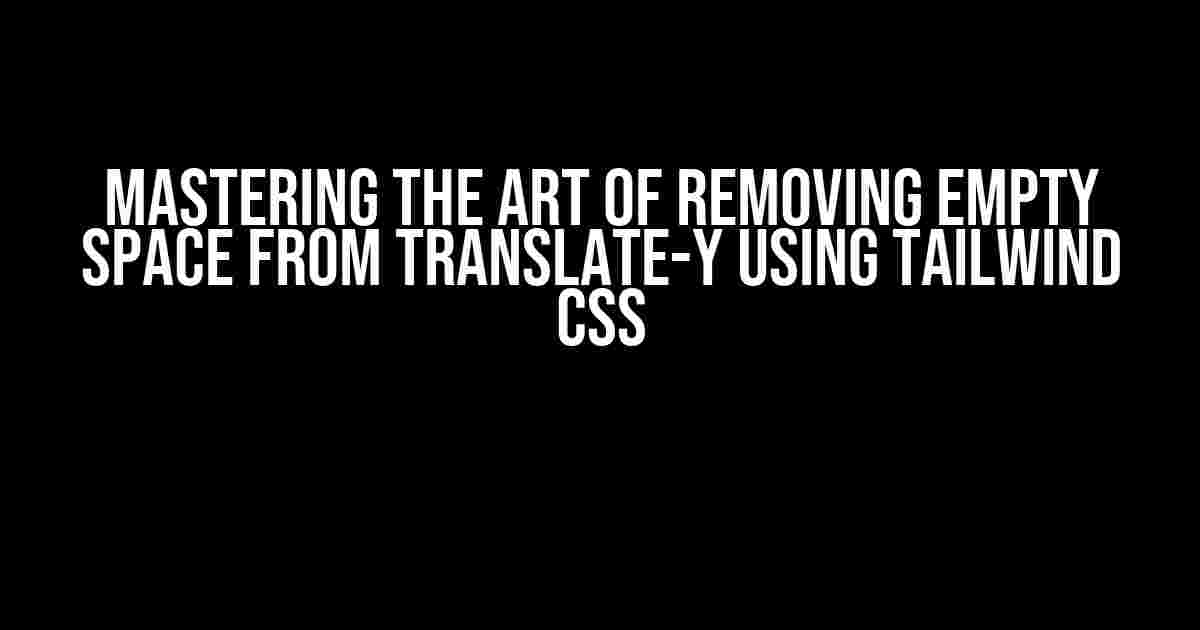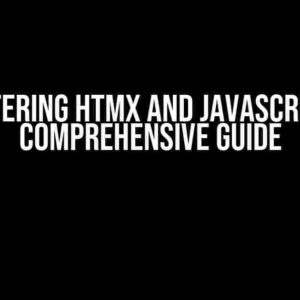Are you tired of dealing with pesky empty spaces when using the translate-y utility in Tailwind CSS? You’re not alone! In this comprehensive guide, we’ll dive into the world of vertical spacing and explore the best practices for removing empty space from translate-y using Tailwind CSS.
Understanding Translate-Y: A Brief Introduction
Before we dive into the solution, let’s quickly review what translate-y is and how it works. Translate-y is a utility in Tailwind CSS that allows you to move an element vertically by specifying a value. This value can be a percentage, a pixel value, or even a viewport unit. The syntax is simple: translate-y-{value}.
This element will be moved 10px down from its original position.
The Problem with Empty Space
Now, let’s talk about the issue at hand: empty space. When you use translate-y, you might notice that it creates an empty space at the top of the element, effectively pushing the content down. This can be frustrating, especially when working with responsive designs or trying to achieve a specific layout.
This element will create an empty space of 10px at the top.
Why Does This Happen?
The reason for this empty space is due to how translate-y works under the hood. When you apply translate-y, it creates a new stacking context, which affects the layout of the element and its siblings. This can lead to unexpected whitespace, which can be problematic.
The Solution: Removing Empty Space from Translate-Y
Fear not, dear developer! There are several ways to remove empty space from translate-y using Tailwind CSS. Let’s explore the most common solutions:
Method 1: Using the `transform` property
One way to remove empty space is by setting the `transform` property to `translateY()` and specifying the value. This method works because it applies the translation directly to the element, without creating a new stacking context.
This element will be moved 10px down without creating empty space.
Method 2: Using the `top` property
Another approach is to use the `top` property and set it to the negative value of the translation. This method works by adjusting the element’s position relative to its parent.
This element will be moved 10px down without creating empty space.
Method 3: Using the `margin` property
A third solution is to use the `margin` property and set it to the negative value of the translation. This method works by adjusting the element’s margin, which effectively removes the empty space.
This element will be moved 10px down without creating empty space.
Method 4: Using a Wrapper Element
If you’re working with a complex layout or need more control over the translation, you can use a wrapper element to contain the translated element. This method works by creating a new context for the translation, allowing you to remove the empty space.
This element will be moved 10px down without creating empty space.
Best Practices for Removing Empty Space
Now that we’ve covered the solutions, let’s discuss some best practices to keep in mind when removing empty space from translate-y:
- Choose the right method**: Depending on your use case, one method might be more suitable than others. Experiment with different approaches to find the one that works best for your project.
- Be mindful of responsive designs**: When working with responsive designs, make sure to adjust the translation value accordingly to ensure that the empty space is removed consistently across different screen sizes.
- Test thoroughly**: Always test your implementation across different browsers and devices to ensure that the empty space is removed correctly.
Conclusion
In this article, we’ve explored the world of translate-y in Tailwind CSS and learned how to remove empty space from this utility. By mastering these techniques, you’ll be able to create more robust and visually appealing layouts, free from unwanted whitespace.
Remember, the key to success lies in understanding the underlying mechanisms of translate-y and choosing the right approach for your specific use case. With practice and patience, you’ll become a pro at removing empty space from translate-y in no time!
| Method | Description |
|---|---|
| Using the `transform` property | Applies the translation directly to the element, without creating a new stacking context. |
| Using the `top` property | Adjusts the element’s position relative to its parent. |
| Using the `margin` property | Adjusts the element’s margin, effectively removing the empty space. |
| Using a Wrapper Element | Creates a new context for the translation, allowing you to remove the empty space. |
By following these best practices and solutions, you’ll be well on your way to mastering the art of removing empty space from translate-y using Tailwind CSS.
- Understand the basics of translate-y and its limitations.
- Choose the right method for your specific use case.
- Test thoroughly and adjust as needed.
- Practice makes perfect!
Happy coding, and remember to keep those layouts tight and whitespace-free!
Here are the 5 Questions and Answers about “remove empty space from translate-y using tailwind CSS”:
Frequently Asked Question
Got stuck with pesky empty spaces when using translate-y in Tailwind CSS? Don’t worry, we’ve got you covered!
Why do I get an empty space when using translate-y in Tailwind CSS?
When using `translate-y` in Tailwind CSS, an empty space is created because the element is still occupying its original space in the document flow, even though it’s being translated vertically. To remove this empty space, you need to adjust the element’s position or display properties.
How do I remove the empty space when using translate-y in Tailwind CSS?
To remove the empty space, you can add `transform: translate-y(-100%)` and `position: absolute` to the element. This will take the element out of the document flow and remove the empty space. You can also use `display: inline-block` or `float: left` depending on your use case.
Can I use margin or padding to remove the empty space?
No, using margin or padding will not remove the empty space created by `translate-y`. These properties will only add or remove space between elements, but won’t affect the element’s original position in the document flow.
What if I need to keep the element in the document flow?
If you need to keep the element in the document flow, you can use `display: flex` or `display: grid` on the parent element, and then use `margin-top` or `padding-top` to move the element up. This will remove the empty space without taking the element out of the document flow.
Are there any other solutions to remove the empty space?
Yes, there are other solutions like using `height: 0` or `visibility: hidden` on the element, but these might affect the element’s layout or accessibility. You can also use a wrapper element with `display: flex` or `display: grid` to remove the empty space. It’s essential to choose the solution that works best for your specific use case.
Let me know if you need any further changes!





